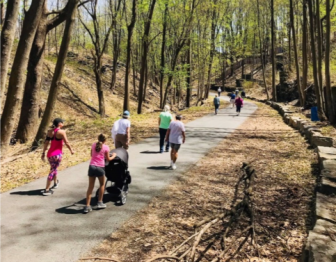Investing in Well-Being of People and Places
Nestled on the scenic Lehigh River, Slatington became the center of the slate industry, producing slate for everything from roof tiles to chalkboards. The town grew as shipping was made easier with the openings of the Lehigh Canal, then the railroad. In the 20th century, industries dimmed, mills closed, and the railroad stopped running. Slatington, Walnutport across the river, and the area surrounding them have remained a small rural community. Forested hills, streams, and historic buildings make the community a beautiful place to live.
“The problem was that kids had nothing to do, some were getting in trouble, drugs were becoming a problem.” said Michele Raber, a Health and Phys Ed Teacher, who has been teaching for 39 years at Northern Lehigh School District, which is comprised of Slatington, Walnutport and Washington Township. “Nearly half our families were lower income, they needed extra help. We didn’t have a YMCA. The kids needed a place to go and organized recreation programs, so did senior citizens. I couldn’t just sit by and do nothing, so 23 years ago we started with a senior stretch class and grew from there.”

Raber and a dedicated core group of eight concerned citizens realized a community recreation center was needed and set out on a mission to create it. They started reaching out for support. “We got the backing of our State Senator and Representative, and some local companies who understood the need,” Raber recalled. “But we also had a lot of naysayers who said it was too big a project for our small community and that we couldn’t do it.”
The group of volunteers was undaunted, they continued to expand recreation programs in borrowed spaces, and raising money for a community center. At the same time, county government and local trail groups were working with the Delaware & Lehigh National Heritage Corridor to develop the D & L Trail through town along the Lehigh River. The trail will eventually span 165 miles from Wilkes-Barre to Bristol. The Slate Heritage Trail was also being planned to run along Trout Creek west from Slatington to Slatedale.
Over thirteen years, Raber’s group raised $600,000. The funds were enough to buy a parcel of land near the D & L Trail and construct the shell of the community center. “It wasn’t enough to finish the center, but people could see the possibilities and wanted the center completed,” said Raber. “By this time our group of volunteers was burning out. We knew we needed additional help and more sustainable funding.”

The group went back to municipal leaders and asked for funding. They got technical assistance from the Pennsylvania Department of Conservation & Natural Resources (DCNR). Working together with the same three municipalities that make up the Northern Lehigh School District – Slatington and Walnutport Boroughs, and Washington Township – they were able to form the multi-municipal Northern Lehigh Recreation Authority (NLRA) in 2015. With funding commitments from each of the municipalities to pay $3 per resident, NLRA was able to secure a DCNR Circuit Rider Grant to hire a paid executive director. In 2016 they hired an executive director for the job, who had experience in recreation management and fundraising.
Having the sustained financial commitment of three municipalities to invest a small amount per resident annually and the Circuit Rider Grant was a big turning point. It enabled formation of NLRA and having a paid director, not just volunteers. Since then NLRA expanded programs that get more kids, families and senior involved in active recreation. Over 5,000 people participated in NLRA programs in 2018. Many of the programs are utilizing the growing trails network in the area, including the Night Hike Series, Family Snowshoeing, Naturalist-led Bike Rides, Walk with Ease, and Nature Photo Walk. NRLA has also expanded its summer programs for kids, working collaboratively with the Northern Lehigh School District.

A feasibility study for completing the construction and operation of the community center has been completed. The plan outlines a sustainable funding strategy that leverages the financial support provided by the municipalities with program fees, membership fees, rental fees, grants and fundraising.
D & L Trails Program Manager, Brian Greene, has been working with local volunteers and businesses to make Slatington a trail friendly community. “They have a beautiful trailhead now with bathrooms and a pavilion,” said Greene. “The trailhead is used for lots of events, a farmer’s market, food trucks, and now a welcome center staffed on summer weekends by NLRA. Trail users counts on the D & L Trail at Slatington were over 24,000 last year. Thanks to the leadership of NLRA and local business owners, there have been many recent improvements connecting the town to the trail. These include new signage, beautification of the trailhead, and bike racks along Main Street. This is a great example of a recreation group and local government working together to improve the trail and town for residents and visitors alike.”
Lessons Learned:
- A small group of concerned citizens can be the catalyst for positive change if they are persistent, especially if they can raise the funds to get a project started.
- Make effective use of volunteers to accomplish small projects that create positive change and build support for larger projects.
- Be prepared for volunteer burnout by continuing to recruit new people to help.
- Be prepared for naysayers by developing feasibility plans that address their concerns.
- Pooling resources with neighboring communities, allows small communities to accomplish more than they can alone. Forming multi-municipal organizations can achieve greater results.

